Developing the Young Workforce: 2017-2018 progress report
The fourth annual progress report of the Developing the Young Workforce (DYW) programme.
Chapter 6 – Performance Assessment & Evaluation
Key Performance Indicators
When we published Developing the Young Workforce (DYW) - Scotland's Youth Unemployment Strategy in December 2015, we made a commitment to report annually on the progress of its implementation over its seven year life span.
The DYW programme has eleven Key Performance Indicators (KPIs) which underpin the programme in terms of areas where we are focusing on improvement. Established at the programme’s outset were deliberately ambitious. We were clear that implementation would require significant changes to how young people, practitioners, schools, colleges, training providers and employers behave and interact. The programme also required the collective support of a number of public bodies and organisations to provide further detail on each measure.
Alongside the programme’s KPIs, a number of milestones were identified for each part of the system to demonstrate what we might expect to change each year. The table overleaf lists our progress to date against these eleven areas.
Looking ahead, we are developing a programme-wide evaluation of DYW. This evaluation will involve both formative (process) and summative (outcome) aspects, offering opportunities for evidence-based practice improvement alongside an evaluation of DYW’s impacts.
The evaluation will commence with a structuring phase. Drawing on our logic model of impact, DYW outcomes will be prioritised and the output of each used to develop a series of questions which will guide all subsequent stages of the evaluation.
In terms of formative evaluation, we will prioritise equalities, and the work of the DYW Regional Groups. Existing evidence from DYW KPIs, and from the DYW Regional Groups Evaluation Report[3], highlights the potential value that formative evaluation in these areas can offer in terms of practice development in support of improved outcomes.
The formative evaluation activity will lead us onto the summative programme-wide evaluation. This will include evidence mapping exercises, workshops with key stakeholders, attribution analysis, and thematic case studies.
The programme-wide evaluation will complement smaller scale evaluation activities to be undertaken within each DYW Change Theme.
We will provide an update on this activity in the next annual progress report, and commit to reporting on this between now and 2021.
KPI
Overarching target
To reduce the level of youth unemployment (excluding those in full-time education) by 40 per cent by 2021
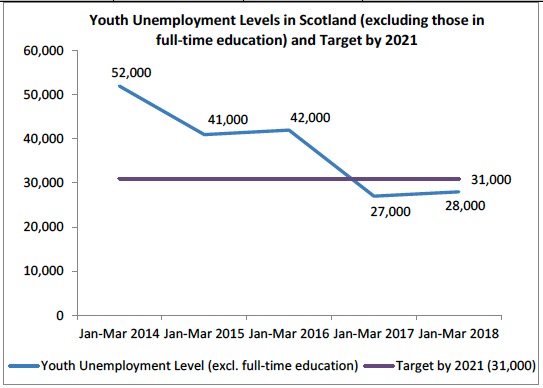
- The number of 16-24 year olds who were unemployed (excluding those in full-time education) increased slightly from 27,000 in Jan-Mar 2017 to 28,000 in Jan-Mar 2018.
- Despite the small increase in the level of youth unemployment over the year, we have continued to achieve the headline target for the Developing the Young Workforce programme, with a decrease of 24,000 (46.4%) since the baseline in 2014.
Data Source and Frequency: Labour Force Survey (ONS). Annual, using Jan-Mar data.
KPI 1
Be one of the top five performing countries in the EU for youth unemployment by reducing the relative ratio of youth unemployment to 25-64 unemployment to the level of the fifth best country in the EU by 2021
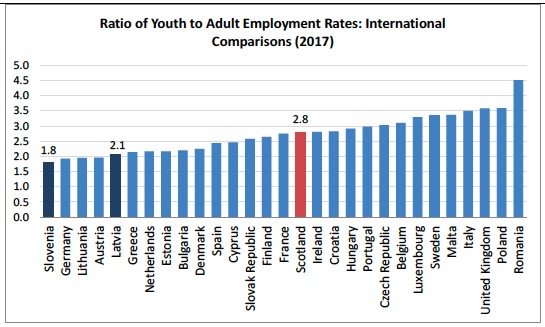
- The ratio of youth (16-24) unemployment to 25-64 unemployment has decreased from 3.7 to 2.8 since the baseline rates were measured. This is due to the reduction in the youth unemployment rate relative to the adult unemployment rate. (E.g. for every 1 percentage point drop in the adult unemployment rate, the youth unemployment rate needs to fall about 2.8 percentage points for the ratio to remain at this level.)
- This ratio has decreased from 3.2 in 2016 to 2.8 in 2017.
- The ratio of the 5th best performing country in Europe is 2.1 (Latvia).
- Scotland is the 16th best performing country in Europe in terms of the ratio of youth to adult employment.
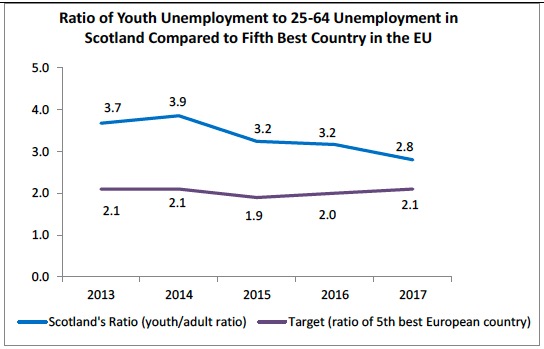
Data Source and Frequency: Scotland data: Annual Population Survey (ONS); EU data: OECD Stat. Scotland data: Annual, by calendar year; EU data: Annual
KPI 2
Be one of the top five performing countries in the EU for youth unemployment by reducing the youth unemployment rate to match the fifth best country in the EU by 2021
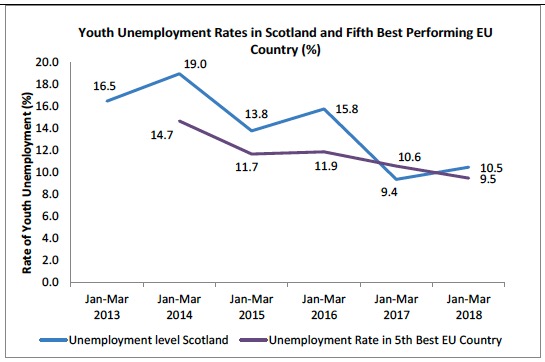
- For the period January- March 2018 the youth unemployment rate has increased over the year to 10.5%; making Scotland the ninth best performing EU country.
- The fifth best performing EU country is Bulgaria, with a youth unemployment rate of 9.5%. This is 1 percentage point lower than the Scotland youth unemployment rate for the same period.
- The youth unemployment rate in the UK is 11.5% for January - March 2018, 1pp higher than the rate in Scotland for this period
Data Source and Frequency: Scotland data: Labour Force Survey (ONS); EU data: Eurostat (European Commission). Scotland data: Annual, using Jan-Mar data; EU data: Annual, using February data
KPI 3
Increase the percentage of school leavers attaining vocational qualifications[4] at SCQF level 5 and above by 2021
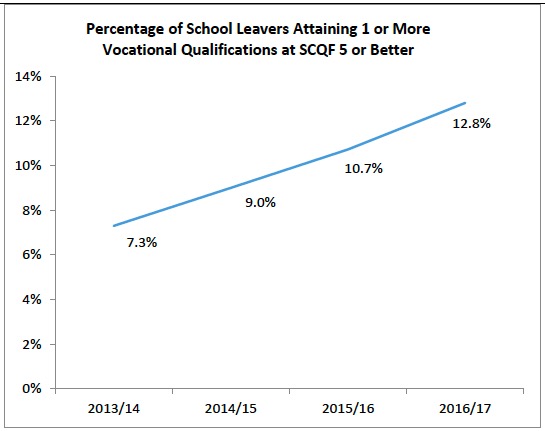
- There has been a year on year increase in the number of school leavers achieving vocational qualifications at SCQF level 5 and above. 12.8% of 2016/17 school leavers achieved a vocational qualification. This is an increase of 2.1 percentage points since 2015/16, and an increase of 5.5 percentage points since the baseline in 2013/14.
Data Source and Frequency: 2016/17 School Leaver Statistics: data from Awarding Bodies (SQA for baseline data) and SG Pupil Census. Annual Data.
KPI 4[5]
Increase the percentage of 16-24 year old college students who have successfully completed a full time course moving into employment or higher level study
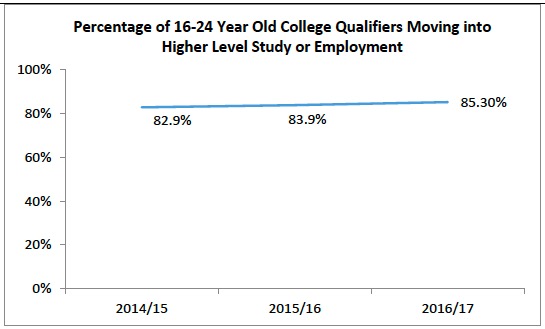
- The data for 2014/15 has been used to baseline as this represents the % of confirmed destinations of 16-24 year olds in a positive progression. (The data for 2013/14 has not been used as this was experimental data.)
- The number of 16-24 year old college students moving into employment or higher level study after successfully completing a full-time course has increased by 2.4 percentage points from 2014/15 to 2016/17.
Data Source and Frequency: College Leaver Destination Survey (SFC) Annual, by college year
KPI 5
Increase the number of Modern Apprentices at level 3 and above. The target is for 20,000 out of a total of 30,000 MA starts to be at this level by 2021, i.e. two-thirds
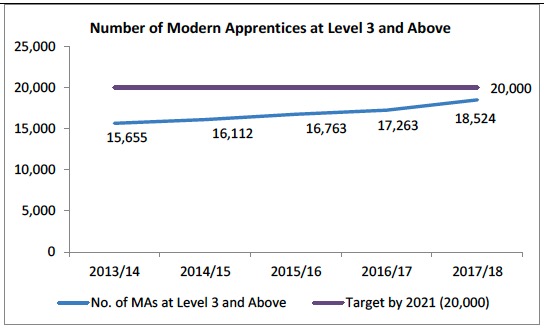
- The number of MA starts at level 3 and above increased from 17,263 in 2016/17 to 18,524 in 2017/18.
- This is an increase of 2,869 since the baseline in 2013/14.
- This year on year increase suggests we are on target to achieve the target of 20,000 MA starts at level 3 and above by 2021.
Data Source and Frequency: Modern Apprenticeship Statistics: Full Year Report (SDS). Annual, by financial year (April-March)
KPI 6
Increase the percentage of employers recruiting young people directly from education to 35 per cent by 2021
- Baseline figure (2014): 32%
- Current figure (2016): 32%
- The percentage of employers recruiting young people directly from education has remained stable at 32% since the baseline was measured in 2014.
- The Employer Perspectives Survey (EPS), which is the data source for this KPI, was not updated in 2018. The EPS was previously carried out by DfE for the whole of the UK, however DfE decided to not proceed with the EPS. As a result, the Scottish Government have commissioned a Scotland EPS to be carried out at the end of 2018/2019. This will produce an updated figure in October 2019.
Data Source: EPS Scotland. Frequency TBC.
KPI 7
To reduce to 60 per cent the percentage of Modern Apprenticeship frameworks[6] where the gender balance is 75:25 or worse by 2021
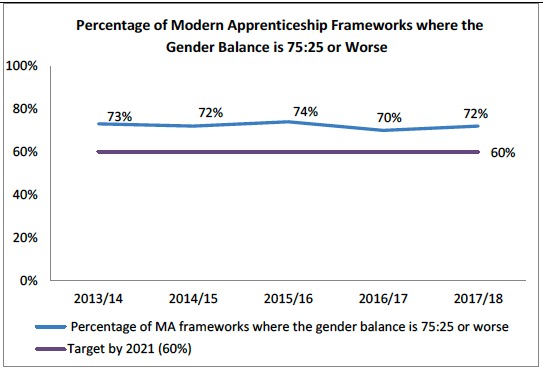
- The percentage of Modern Apprenticeship frameworks where the gender balance is 75:25 increased from 70% in 2016/17 to 72% in 2017/18.
Data Source and Frequency: Modern Apprenticeship Statistics: Full Year Report (SDS). Annual, by financial year (April- March)
KPI 8
Increase by 5 percentage points the minority gender share in each of the 10 largest and most imbalanced college superclasses[7] by 2021
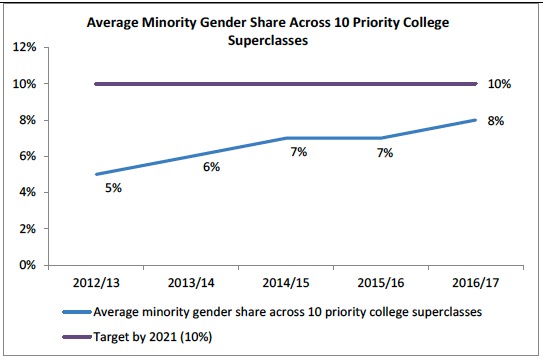
- The minority gender share currently ranges from 3% in Building/Construction Operations to 16% in Engineering/Technology (general).
- The minority gender share increased by at least 1 percentage point in 6 out of the 10 largest and most imbalanced college superclasses between 2015/16 and 2016/17.
- This has increased by at least 1 percentage point in 9 out of the 10 largest and most imbalanced college superclasses from the baseline measurement in 2012/13.
- The largest increases from the baseline have been in Building Services (2% in 2012/13 to 9% in 2016/17) and Engineering/Technology (9% in 2012/13 to 16% in 2016/17). The minority gender share in each of these superclasses has increased by 7%.
Data Source and Frequency: Further Education Statistics collection (SFC). Annual, by college year
KPI 9
Increase the number of MA starts from minority ethnic communities to equal the population share by 2021
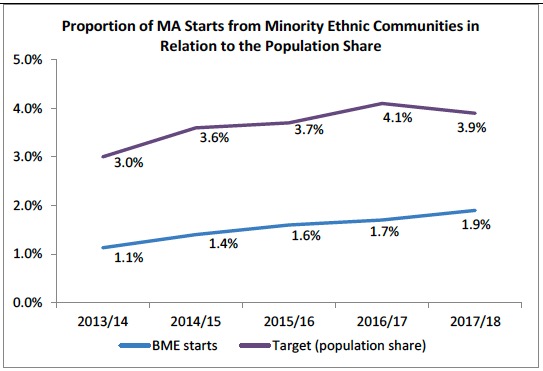
- This target will change year on year as the population share figure is updated
- The percentage of MA starts from minority ethnic communities increased from 1.7% in 2016/17 to 1.9% in 2017/18. This is an increase of 0.8 percentage points since the baseline (2013/14).
Data Source and Frequency: Modern Apprenticeship Statistics: Full Year Report (SDS). Annual, by financial (April-March). Annual Population Survey (ONS) (April-March).
KPI 10
Increase the employment rate for young disabled people to the population average by 2021
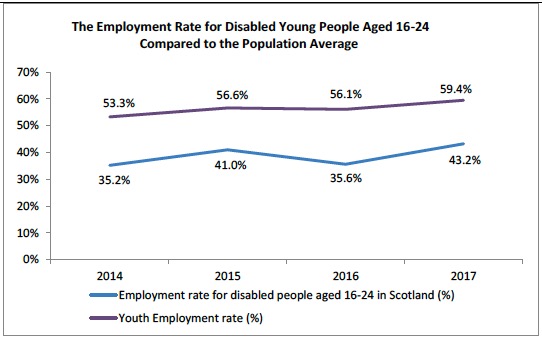
- The employment rate for young disabled people increased from 35.6% in January–December 2016 to 43.2% for the same period in 2017.
- This is an increase of 8.0 percentage points compared to the baseline figure of 35.2% (Jan-Dec 2014).
- The target for 2017 is 59.4% – the target will change each year as the youth employment rate changes.
- There is currently a gap of 16.2 percentage points; down 1.9 percentage points from 18.1% in 2014.
Data Source and Frequency: Annual Population Survey (ONS) Annual, by calendar year
KPI 11
Increase positive destinations for looked after children by 4 percentage points per annum resulting in parity by 2021[8]
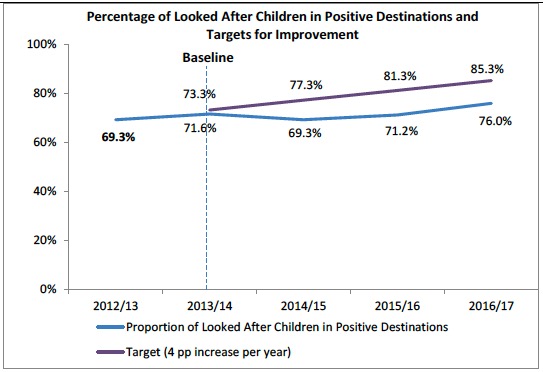
- The “looked after children‟ cohort reflects children who have been looked after for the full year only.
- The proportion of looked after children in positive destinations is 76.0% in 2016/17. This is an increase of 4.8 percentage points since 2015/16, and an increase of 6.7 percentage points since the baseline figures were recorded in 2012/13.
Data Source and Frequency: Educational Outcomes for Looked After Children (SG). Annual, by school year
Contact
Email: Paul Fagan
There is a problem
Thanks for your feedback